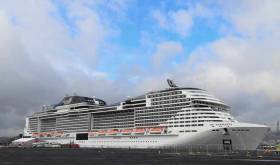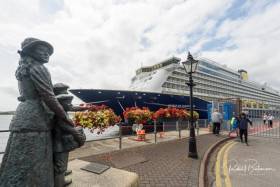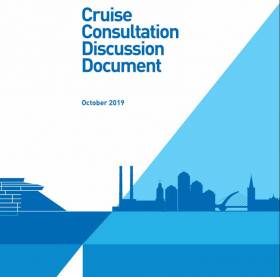Displaying items by tag: Cruise liner
Viking Venus Anchors in Dublin Bay as Dun Laoghaire Welcomes First Cruise Liner of the Season
This morning, the Viking Venus cruise liner anchored off Dun Laoghaire Harbour, marking the beginning of the 2024 cruise season that runs from April to October. The season includes 80 visits by cruise liners to the south Dublin town.
The Viking Venus is a small ship that has won awards and has verandas for all its 930 guests. Due to its size, it can dock where larger ships cannot, the company Viking claims.
The 745-foot ship arrived in Dun Laoghaire just after 7 am and immediately disembarked passengers by tender.
The 2024 cruise programme for Dun Laoghaire Harbour is available to download below.
The Viking Venus is viewable on the Dublin Bay ship anchorage webcam here
Following a voyage from Belfast Lough, The Ambience sailed past Roches Point this morning, becoming the first cruise line visitor to Cork Harbour of 2023.
Anticipating a strong year, the Port of Cork has seen bookings return to pre-pandemic levels, with 113 vessels expected in 2023, compared to 100 vessels in 2019.
The 245-metre Ambience docked quayside in Cobh Cruise Terminal at 12:00 pm and departed at 19:00 hours for Cherbourg in France.
The video below is by Mary Malone.
Speaking about the 2023 Cruise Schedule, Conor Mowlds, Chief Commercial Officer at the Port of Cork Company stated, “Last year, we were delighted to welcome over 115,000 passengers on 90 cruise ships to Cork following a two-year pause as a result of the pandemic. Now, we look forward to what is expected to be a thriving year in the cruise liner industry as bookings return to pre-pandemic levels, which will positively impact the local region’s tourism and trade. All of us here at the Port of Cork look forward to welcoming the cruise liners, passengers and crew in the coming months.”
The Ambience cruise-call to the south coast of Ireland chimes with other early bird arrivals around the coast, such as the 227-metre long Norwegian flagged Viking Venus anchored at Dun Laoghaire Harbour, on the east coast on April 5th, as Afloat reported here.
Cruise Liner Viking Venus Arrival Marks Start of Dun Laoghaire Harbour's 2023 Summer Season
The 227-metre long Norwegian flagged Viking Venus anchored on Dublin Bay this morning just outside Dun Laoghaire Harbour, marking the start of the 2023 cruise liner season at the east coast port.
More than 90 Cruise Liner visits are booked for the east coast port for 2023, beginning with the call of the Venus this morning and closing out the season with the Norwegian Star on 20 October.
The harbour has 92 visits booked for the season thus far (subject to change).
The anchored Viking Venus is visible on this Dublin Bay anchorage live cam below and shows passengers being ferried ashore by the ship's orange-coloured tenders to the new purpose-built tender berth at Dun Laoghaire Harbour.
That figure represents a 40% increase on 2022’s cruise call numbers when 65 visits were on the books.
Some of these will be repeat visitors — with the Norwegian Dawn slated for an exceptionally busy season with 13 calls from May to October.
The weekend visit of the ship Greg Mortimer was the first cruise-liner to berth alongside at Dun Laoghaire Harbour in the 2022 season.
Capable of negotiating the strongest winds and waves, the 104-metre Greg Mortimer is built to polar standards as a purpose-built expedition vessel.
Arriving in Dun Laoghaire on Friday directly from Cartagena, Colombia, the ship specialises in tours of the Arctic and Antarctic regions.
 The expedition Vessel Greg Mortimer alongside at Dun Laoghaire Harbour
The expedition Vessel Greg Mortimer alongside at Dun Laoghaire Harbour
The Greg Mortimer features a patented inverted bow concept designed to handle challenging ocean waves.
On Saturday evening, the ship departed Dun Laoghaire Harbour bound for Portrush in Northern Ireland.
No sooner had Greg Mortimer departed, than the 466 ft Laustral arrived at the Dublin Bay anchorage in what is a busy weekend for Dun Laoghaire cruise-liner traffic.
 The 466 ft Laustral on the Dublin Bay anchorage Photo: Afloat
The 466 ft Laustral on the Dublin Bay anchorage Photo: Afloat
Live Dublin Bay webcams here
Dun Laoghaire Harbour Publishes 2022 Cruise Ship Schedule as Third Liner Expected on Wednesday
Dun Laoghaire Harbour has published a schedule of its cruise liner calls this year with many of the liners anchoring on Dublin Bay and tendering passengers ashore.
A ‘cap’ on the number of cruise calls to Dublin Port since 01 January 2020 has consequently seen an increase in the number of bookings of ‘tender’ calls to Dun Laoghaire, the former ferry port. Dun Laoghaire's cruise calls are listed below.
 Diagram of harbour showing tender route
Diagram of harbour showing tender route
As Afloat previously reported, new pontoon facilities are now in place at the harbour to facilitate embarkation and disembarkation from some 78 expected cruise liner calls running until October.
 Pontoon from the east with typical tender (of 15m length overall) alongside at St Michael's Wharf
Pontoon from the east with typical tender (of 15m length overall) alongside at St Michael's Wharf
The next ship to arrive at Dun Laoghaire will be the 300-metre long MSC Magnifica that arrived in Cork Harbour today (Tuesday, April 19th) as pictured by Bob Bateman above.
The 3,000 passenger ship is expected into Dun Laoghaire on the Irish east coast on Wednesday, April 20th where she will anchor in the bay and tender passengers ashore.
Dun Laoghaire Harbour 2022 Scheduled Cruise Calls


Norwegian Viking Venus Cruise Liner is First to Use Dun Laoghaire's New Passenger Ship Tender Pontoon
Dun Laoghaire Harbour's newly installed 'primary passenger ship tender pontoon' was put to immediate use this weekend to facilitate the second cruise-liner visit of the season to the east coast port.
Tenders from the Viking Venus Cruise Ship were the first to use the facility that brings cruise passengers to awaiting coaches in the harbours' compound which means no disruption to harbour car parks.
As Afloat reported previously, the new 40m x 4.5m floating pontoon is now located at No 4 berth on the east side of St Michael’s Pier. The pontoon was assembled at the nearby Carlisle Pier and towed to the berth.
 The Viking Venus Cruise Ship Tender disembarks passengers at the new pontoon berth at Dun Laoghaire Harbour on Sunday
The Viking Venus Cruise Ship Tender disembarks passengers at the new pontoon berth at Dun Laoghaire Harbour on Sunday
Tender operations for the visiting ships, (anchored in the bay) will now take place from No 4 berth using the nearby compound for awaiting coaches.
The move has the added benefit of freeing up the town's Carlisle Pier for sailing events and boat storage.
And the newly installed glass wall at the plaza overlooking the berth means the visiting ship at anchor and the tendering operation itself is now visible from the quayside.
The next liner to use the new dock will be the MSC Magnifica on Wednesday, April 20th.
 The new pontoon comes complete with gangway, mooring bollards, ramps and steps for the safe disembarkation of passengers
The new pontoon comes complete with gangway, mooring bollards, ramps and steps for the safe disembarkation of passengers
Belfast Harbour Named Best Cruise Port of Call in UK & Ireland
Belfast Harbour has been named the best port of call in the UK and Ireland for cruise ships. The accolade was awarded by a global panel of cruise experts as part of the 2019 Cruise Critic Editors’ Pick Awards.
It follows a record-breaking 2019 cruise season for the city with 146 cruise calls and 280,000 visitors. The judges were particularly impressed by a £500,000 investment by Belfast Harbour and Tourism NI in the island’s first dedicated cruise terminal which was officially opened in July.
The welcome facility, which includes a Visitor Information Centre managed by Visit Belfast, also boasts new facilities for coaches and taxis, and an easily accessible deep-water berth to accommodate larger cruise ships. The judges also praised the location of the terminal for providing “easy access to the city’s world-class attractions, such as Titanic Belfast in the city's famous Titanic Quarter”.
Joe O’Neill, Belfast Harbour’s CEO, said: “With our partners Visit Belfast we’ve worked hard to market Belfast Harbour and Northern Ireland under the ‘Cruise Belfast’ initiative as one of the best cruise destinations in Western Europe. We’ve also invested in a new terminal with the support of Tourism NI to encourage further growth in this strategically important sector. Considering the quality of other destinations in the UK and Ireland, we’re delighted to win the award”.
If you had left Belfast twenty years ago (as many did) you would remember the city as having turned its back on the River Lagan. Not so today. The waterfront has developed beyond imagination with of course, the magnificent Titanic Belfast, the Marina and many office and apartment blocks, river cruises and maritime festivals. Belfast Harbour is Northern Ireland’s leading gateway and key economic hub for trade and tourism, handling more than 70% of the region’s seaborne imports and exports. The 2,000-acre Harbour Estate hosts more than five million annual visits, including 1.5 million ferry and cruise ship passengers. It’s home to a vibrant mix of 760 businesses working across multiple sectors, to include marine logistics and heavy engineering, commercial and residential real estate, retail, financial and IT services, tourism and leisure, media and creative industries.
And helping feed the economy is the successful cruise tourism sector which encourages new tourist and leisure projects, and further enhances Belfast’s reputation as a leading destination, including within the cruise market.
Gerry Lennon, Chief Executive of Visit Belfast, added: In the 20 years since Visit Belfast was established, we have worked with Belfast Harbour to attract cruise visitors to the city and region, and the result has been an enormous increase in the number of visitors and ships coming to the city. In total, Cruise Belfast has brought 784 ships to the city since 1999, and in the last five years alone, cruise visitor numbers have increased by 135%.
John McGrillen, Tourism NI Chief Executive, commented: “This is a great achievement for Belfast’s international visitor reputation and is a result of major investment in the cruise tourism market which saw the opening of our first dedicated cruise terminal in July. The new terminal can accommodate bigger cruise ships bringing visitors from key markets across Europe and ensure that once they are here, they are easily able to access all of our world-famous attractions and hospitality.
The awards are based on Cruise Critic editors’ impartial cruise expertise which draws upon first-hand experiences and industry knowledge. Adam Coulter, UK Managing Editor, Cruise Critic said: “The desire for more experiential holidays, especially amongst younger travellers is certainly helping to boost the UK cruise sector. There is more choice than ever before in ocean, river and expedition cruises as a result of an array of exciting new ships launched this year and next. Whether you are cruising as a multi-generational family, a couple or solo, there really is a cruise for everyone.”
In addition to its record-breaking cruise season, Belfast Harbour also welcomed several firsts during 2019. These included the visits of ‘Disney Magic’ and SAGA’s first ever new build vessel, the ‘Spirit of Discovery’. The port also welcomed 6,500 visitors and crew onboard the ‘MSC Meraviglia’, the largest ship by passenger capacity to ever visit Belfast. The Harbour has also invested in new facilities to market Belfast as a cruise embarkation port. Cruise & Maritime has already scheduled departures from Belfast for next summer including Norwegian Fjord and British Isles itineraries.
Bumper Cruise Liner Season Brings Over 243,000 Visitors to Cork Harbour
There is only one more cruise ship is left to visit in December, for what has been a record cruise season for the Port of Cork with 100 cruise liners visiting in 2019. In total over 243,000 passengers and crew visited the region with many passengers visiting Cork for the first time.
In 2019, Cobh was recognised as one of the best cruise destinations in the world, winning in the Top-Rated British Isles & Western Europe Cruise Destination category. Destinations awarded in this year’s awards received the highest ratings among cruisers who cruised to the destination in the past year and shared their experiences on Cruise Critic.
Port of Cork Chief Executive, Mr Brendan Keating said: “We are hugely proud of the increase in cruise tourism and growing our business to 100 calls has surpassed our expectations. However in order to successfully promote Cork as a sustainable cruise destination, it takes commitment from local tourism bodies, local businesses and Cork City and Cork County Council to work together to enhance the reputation of Cork globally.’
He continued: ‘On average, cruise ship passengers spend €81 during their visit to Cork while crew spend approximately €29. Improving and exciting the passengers' shore experience will encourage a return visit to the region increasing tourism and boosting the local economy.’
As well as Cobh the Port of Cork also operates Bantry Bay Port Company which saw 10 cruise liners calling to the West Cork area this summer. Bantry Harbour and Glengarriff can accommodate the smaller boutique and expedition-style cruise liners whose passengers tend to look for an active cruise. Bantry Bay Port Company has developed a cruise strategy for Bantry in order to grow the business in West Cork. The smaller cruise liner market or ‘expedition’ market has huge growth potential and it is this market that Bantry hopes to capitalise on over the next few years, with the guidance of the Port of Cork.
The cruise industry which anticipates that 30 million passengers globally will cruise in 2019 has seen a major shift in the demographic now taking to the seas. Cruising is seen as an attractive, affordable method of travel, offering passengers multiple destinations and an array of experiences.
What has also become clear is that according to the Cruise Lines International Association (CLIA) travellers want to see the world in a conscious, mindful way and the cruise industry is more conscientious than ever, working carefully to minimize environmental footprints.
Cruise Tourism in Dublin Port: Public Consultation Opens
Dublin Port Company (DPC) has launched a public consultation on the future of cruise liner tourism at Dublin Port. To help inform the consultation process, DPC has published a discussion paper setting out key considerations to be addressed. DPC has also published the findings of an independent economic cost-benefit analysis by Indecon International Economic Consultants and recent research by Fáilte Ireland on expenditure by cruise tourists in Dublin.
The consultation, which opens today and runs until 17th January 2020, seeks the views of stakeholders on the future development of cruise tourism in Dublin regarding a number of issues, including:
- The appetite of the City of Dublin for large-scale cruise tourism;
- Environmental considerations, specifically air emissions;
- The financial challenge of funding proposed new cruise berths.
The context for the consultation is Dublin Port’s Alexandra Basin Redevelopment (ABR) Project, which is currently under construction. The final part of this project will involve building new berths suitable for the largest cruise ships at North Wall Quay Extension, east of the Tom Clarke Bridge. Construction is scheduled to start in 2024, meaning the new berths would be available for the cruise season of 2026.
Widespread Support a Prerequisite
DPC is first and foremost looking to ascertain the level of broad-based appropriate support as a prerequisite for the proposed development. The key question being asked of stakeholders, including the general public, is whether Dublin wants to have a large-scale cruise tourism business. If so, then the proposed berths at North Wall Quay Extension are needed.
Air Emissions
Any new berths that might be constructed will have provision for shore power and cruise ships would be required to turn off their engines and use this shore power while at berth. This mandatory requirement is particularly important given the challenge facing the City to address likely imminent breaches of EU air quality limits. DPC wishes to establish the willingness and ability of cruise lines to meet this requirement in Dublin in the future if the new berths are constructed.
Investment Required
The investment required to construct the new berths at North Wall Quay Extension is estimated at €108 million, excluding terminal facilities for cruise turnarounds. Dublin Port Company projects that this investment could treble the number of cruise tourists to 619,000 by 2040, with approximately one-third of these being turnaround passengers who start and finish their cruise in Dublin. By way of context, Dublin Port received some 197,000 cruise tourists in 2018, and approximately one-fifth were turnaround passengers.
Indecon Report
DPC commissioned Indecon International Economic Consultants to evaluate the economic benefit from the proposed investment and from the projected increase in cruise tourism. Indecon’s key finding is that the economic return would be positive. Indecon estimates that the investment of
€108 million (over the years 2024 to 2026) would generate a net economic benefit of €211 million (at 2019 values), equivalent to a benefit to cost ratio of 2.83.
However, the scale of the investment required and the level of risk are such that DPC could not itself finance the project. The company is currently implementing a €1 billion ten-year capital investment programme to deliver additional capacity to cater for projected cargo growth up to 2040. From a development risk perspective, the proposed new berths would be of limited alternative use outside of cruise, i.e. for revenue-generating cargo operations.
Co-Financing Arrangement
Therefore, if the project is to proceed, co-financing is required (as outlined in Masterplan 2020 – Reviewed 2018, Page 33). This could involve a concession agreement with a private sector operator or operators which would provide the €108 million funding up front in exchange for the right to operate the facility for a defined period. Such an approach is provided for in National Ports Policy. Based on the Indecon analysis, DPC is seeking to establish the level of interest among cruise companies and others to support the required investment and arrangement.
Eamonn O’Reilly, Chief Executive, Dublin Port Company, said: “The first part of this consultation asks whether Dublin wants a large cruise tourism business or not. We need to know that there is widespread support and a genuine desire to see cruise tourism on a significantly larger scale than ever before if we are to proceed to build new berths as far upriver as the Tom Clarke Bridge capable of accommodating the largest cruise ships two at a time.
“The second aspect of the consultation looks at how the construction of new cruise berths at
North Wall Quay Extension can be financed. With the Indecon analysis complete, we are clear about the economic benefits of any such investment, but unclear about the industry’s willingness to co-finance future development. This consultation provides an important opportunity to engage and we welcome responses from all stakeholders, national and international, to the process.”
Submissions
Interested parties are invited to respond to the consultation document (available to download at https://www.dublinport.ie/masterplan/cruise-consultation/ no later than 17th January 2020, either by email to [email protected] or by post to:
Cruise Consultation, Dublin Port Company, Port Centre, Alexandra Road, Dublin 1.
The All-Ireland Cruise Ship Action Group will be appearing before the Oireachtas Committee on Transport, Tourism and Sport today at 1.30pm.
The Group says it will be giving evidence on the impact the Dublin Port Company’s ban on cruise ships will have to the tourism industry, the cross-border economy and for local business in the port cities Cork, Belfast, Dublin and Waterford.
The Committee will also hear evidence on the background to the decision by Dublin Port Company to reduce the number of Cruise Ships coming into the capital.
Tune in at 1.30pm below to hear more.

































































